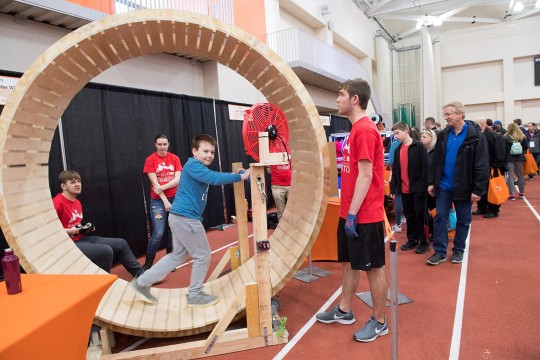News
Mechanical Engineering BS
-
April 12, 2022

Imagine RIT: Creativity and Innovation Festival returns in-person April 23
After going virtual for 2021, the Imagine RIT: Creativity and Innovation Festival is back in person and virtually, planned from 10 a.m. to 5 p.m. on Saturday, April 23, on the RIT campus in Henrietta and online at the Imagine RIT website.
-
April 7, 2022

RIT Esports wins 2022 ‘Hearthstone’ Collegiate Masters Tournament
RIT Esports is a national champion again, after a team of students came out victorious in the 2022 Hearthstone Collegiate Masters Tournament. The Tigers bested more than 200 teams to win the tournament, which is the main event for collegiate Hearthstone and is run by the game’s maker, Blizzard Entertainment.
-
March 29, 2022

Student engineers work with the city of Rochester to improve snow removal
Working with the city’s departments of Data Analytics and Environmental Services’ staff, undergraduate engineering students built a prototype solar monitoring system. It will provide needed information about snow build up on the city’s busiest streets and provide real-time data to staff to open high-traffic areas safely and efficiently.
-
December 13, 2021

RIT and UR professors awarded patent for use of carbon nanotubes for improving delivery of bio-therapies to targeted cells
RIT Associate Professor Michael Schrlau and Ian Dickerson from the University of Rochester Medical Center have received a patent to deliver biomolecules into cells through carbon nanotube arrays.
-
December 8, 2021

Setting the Stage for the Performing Academic
RIT students have never had as many ways to pursue their love of performing arts than they do now. From scholarships, new clubs and classes, private music lessons, community partnerships, and exciting new venues being built on campus, performing arts for RIT students is literally becoming a show stopper.
-
November 18, 2021

RIT names new members to its board of trustees
RIT appointed two new members — who are also alumni — to its board of trustees. Kathy Yu ’91 has more than 20 years of experience in the technology and semiconductor manufacturing sectors. Nick Schneider ’10, ’10 MS is a principal at Boston Consulting Group, where he is a lead in the company’s technology, media, and telco sector.
-
October 8, 2021

Faculty compensation is focus of NSF-sponsored research
To build understanding of faculty compensation systems and improve conversations around salary, several RIT faculty members are sharing their experiences with a National Science Foundation-funded multidisciplinary research team. The team’s goal is to significantly expand knowledge of best practices for faculty compensation to a broader community in higher education and provide insights to guide compensation practices.
-
August 30, 2021

Engineering faculty member receives NIH grant to develop biotechnology to better detect sepsis
As one of the leading causes of death in hospitals, sepsis becomes more complicated with the rise in bacteria most resistant to some of today’s antibiotics. If physicians can detect onset earlier, treatments could begin sooner. Ke Du, a mechanical engineering faculty-researcher, will be developing a microfluidic device to improve detection of drug resistant bacteria in blood.
-
August 9, 2021

Meet Lucas Randrianarivelo, RIT Student Government president
Lucas Randrianarivelo was excited to start college five years ago, but it wasn’t until he became involved in student activities that he felt at home on campus. This year, Randrianarivelo, a fifth-year mechanical engineering major, is RIT Student Government president.
-
August 5, 2021

In the Matrix: Engineering alumna co-founds high tech start-up Sanatela Medical Solutions and develops new tissue engineering system
Erin Crowley Ellis ’08 (mechanical engineering) and her father, Michael Crowley, launched Sanatela Medical Solutions, a new bioengineering company in Rochester.
-
June 28, 2021

2 local ninjas give it their all on American Ninja Warrior
WHEC-TV features Quinn Nguyen, a mechanical engineering student, who competed on American Ninja Warrior.
-
June 11, 2021

RIT wins award to develop game design training platform as part of NASA’s Moon-to-Mars Mission
RIT faculty-researchers will develop a game-design training system that could help astronauts maintain balance, motor skills, and other cognitive functions while in space. NASA, in partnership with the National Space Grant Foundation, has selected six university teams, including RIT, to develop innovative design ideas that will help NASA advance and execute its Moon to Mars exploration objectives.


